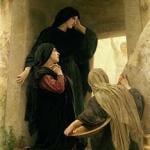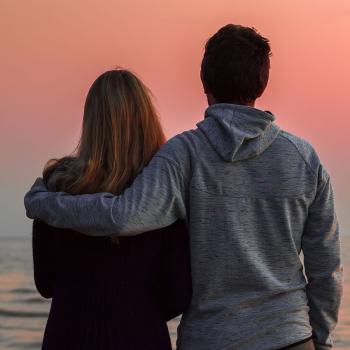
In February 2019, Miguel stared out at the San Pedro Valley in Mexico, stretching for miles below him from his position on Yaqui Ridge in the Coronado National Monument. Standing at Monument 102, which marks the symbolic start of the 800-mile-long Arizona Trail, Miguel remarked on how the border here doesn’t look like what most people imagine.
Instead of 30-foot bollards, all one finds is mangled barbed wire to mark the divide between Arizona and Sonora. Here hikers can dip through a hole in the fence to cross into Mexico, take their selfie, and pop back over.
“It’s as easy as that,” Miguel said, with a melancholic chuckle.
But for Miguel’s mother the crossing was not only difficult — it was deadly. She perished trying to find her way to the U.S. across the valley’s wilderness when Miguel was just four years old and already living in the U.S. with his father.
Not knowing exactly where she died, Monument 102 became a makeshift memorial for Miguel’s mother, the obelisk marking the U.S./Mexico border a kind of gravestone. The barbed wire itself even holds meaning for Miguel. “When I come every year to remember her,” he said, “and the knots in the barbed wire remind me of the cross.
“It may sound strange, but that gives me comfort,” he said.
Miguel is far from alone in making religion a part of the migrant’s journey. As migrants move around, across and through borders and the politics that surround them, religious symbols, rituals, materials and infrastructures help them make meaning, find solace and navigate their everyday, lived experience in the borderlands.
With immigration proving a top issue for voters in the U.S. and Europe this year, this edition of What You Missed Without Religion Class explores the numerous intersections between religion and migration.
Religion on the move
Across epochs and geographies, humans have always been on the move. Their motivations have been many: fleeing war and poverty, looking for adventure or new resources to exploit, a fresh start or a new market for their goods. As they go from one place to the next, they carry their religious ideas, observances and things with them.
Whether it’s Christian missionaries who came to sub-Saharan Africa to baptize new converts, Muslim tradesmen praying on mats from home as they sought new markets in the South Pacific or Buddhist refugees clutching a bronze statuette of Lord Buddha at a transit camp, religion has played a critical role in migrants’ lives and movements.
As the globalization, changing direction, differentiation, proliferation and politicization of migration means that more places are shaped by restrictions and regulations related to immigrant bodies, religion continues to inform the process. It can dictate the routes people take (or whether they go at all) as individuals seek the advice of religious authorities on if, and when, they should migrate.
Religious persecution may also be the motivation for movement, as minoritized communities flee from pressure or persecution in their countries of origin or move to countries where they hope to be in the majority.
Other migrants encounter racialized hatred in their new contexts, stereotyped or discriminated against because of their identification, method of dress or practice. At the same time, they may also experience generosity and hospitality from religious communities who welcome them with positive treatment and practical help along the way. And, as they establish themselves in host countries, religion can be a key determinant factor in the communities they connect to or create and the kinds of connections (or lack thereof) they maintain with those left at “home.”
Haunted lands, halal meals and the politics of preaching
The ongoing ubiquity of religion as part of the migrant experience suggests that relating religion to migration allows us to understand the topic of immigration better. It also makes it possible to expand and enrich our understanding of religion itself.
For example, in his work Undocumented Saints: The Politics of Migrating Devotions, William A. Calvo-Quirós investigates the relationship between state violence, imagination, religiosity, and spirituality along the U.S.-Mexico border region during the twentieth century. He looks at this region not only as a socio-political space of conflict and struggle, but as a 2,000-mile strip of "haunted" land, inhabited by many imaginary creatures, vernacular saints and fantastic tales. Calvo-Quirós's book reminds its readers how migrants’ battles for survival are performed in the worlds of faith, religiosity and the politics of surveillance and control around Latinx religiosity. As Calvos-Quirós puts it, “Within the context of the extreme violence of the physical, geographic, and political, religiosity in particular becomes an essential mechanism for holding together a world that seems to be falling apart.
I saw this firsthand when I spent time at Albergue Assabil, the first shelter for Muslim migrants at the U.S./Mexico border, in 2022. While there, I spoke with migrants who made their way to the shelter in Tijuana from places like Ghana, Afghanistan and Chechnya.
Each with their own stories, they shared how religion both hindered and helped them as they sought economic and political asylum. One refugee shared how he struggled to pray, maintain a halal diet or perform other duties associated with his faith as he made the treacherous journey from West Africa to the southern borderlands through Brazil, the Amazon, Central America and the infamous Migrant Trail. Upon his arrival at Albergue Assabil, he found the prayer space, ablution facilities and halal kitchen an oasis of calm and comfort before he made the final trek through the wilderness to find work to support his family on the other side.
More recently, as I started working on a series of stories on Faith and Immigration for Sojourners magazine, I was reminded of how religious actors — and actions — can shape the policies we put in place around borders and migrants’ bodies. For example, according to a recent Pew Research Center survey, religious Americans differ widely on how they refer to the increase in arrivals at the border. While only 45 percent of all U.S. adults say the large number of migrants is a “crisis,” majorities of white Christian groups — 70 percent of white evangelical Protestants, 64 percent of white Catholics, and 57 percent of white non-evangelical Protestants — feel that it is. In comparison, only 32 percent of Black Protestants and 27 percent of the religiously unaffiliated, or “nones,” say the situation at the border constitutes a “crisis.” More than colloquial conundrum, the sources I spoke to say the language we use determines the policies we support.
It also helps shape the theologies we hold about people crossing borders. This comes into sharp focus in the pulpits of U.S. churches. With immigration at the top of many of their parishioners’ minds, pastors and other religious leaders across the country are being asked to address the topic in their teaching and preaching. But with so much information — and counter-information — floating around, some pastors might not be sure where to begin. They might also wonder what the Bible says about immigration, and what resources are available to make sure they get that message right.
In the months to come, and as debates intensify, it is imperative to not forget the religion angles related to the subject of migrants and immigration.
The student of religion would not only be wise to mark how religion is at play in political disputes; but also remember how religion is a key aspect of how humans move across borders and boundaries, how they make new homes and how they maintain ties with old ones.
4/6/2024 5:39:07 AM





